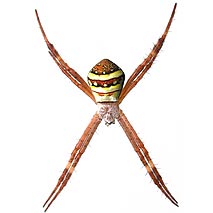
St Andrew's Cross Spider
Argiope keyserlingii
Family: Araneidae ID: Karsch, 1878

Habitat and Biology
The St Andrew's Cross spider commonly builds its web amongst shrubs and other
vegetation or against walls of buildings. It normally hangs upside down in the
web with two paired legs placed along each arm of the cross. The silken cross
may be used for strengthening the web, for camouflage or for enhancing prey
catches. It has been shown that the cross reflects ultra-violet light which
is particularly attractive to insects. Egg sacs are pear-shaped, green in colour
and are suspended in nearby vegetation rather than in the web itself.
Colour
Male: Cephalothorax and legs brown; abdomen cream with a mottled brown pattern.
Female: Cephalothorax brown and covered with silky hairs. Abdomen with horizontal
stripes of yellow and crimson brown, sometimes with pale spots on the brown
stripes. Legs dark brown to black with a few yellowish bands.
Form
Small-bodied with relatively long legs; often appears to have only four legs
due to resting position in web. Male much smaller than female.
Body Length
Male: 4mm
Female: 20mm
Web type
Orb web with a cross of thick silk through its centre.
Bite
The bite of this spider
is considered harmless or at most to cause a weak local reaction. Few bites
have been recorded.